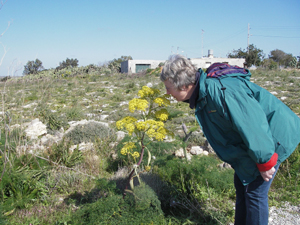|
|
|
Malta |
|
|
Seven months in Malta have just flown by! Whilst writing the rain is pattering onto the deck and the wind is howling in the masts all around us. The Maltese are hoping that this will be the last of the winter which has been the wettest and coldest for 18 years. The temperature has been down to +10C. We are now looking forward to pleasant summer months among the Greek islands and the next winter in Finike, Turkey, which we have already booked. What have we been up to all these months? We often get the question: “What do you do with yourselves all day?” Apart from living every day life – granted a little bit different compared to back home – we have tried to see and learn as much as possible about Malta. The every day life has consisted of shopping, cooking, cleaning and doing the washing. Shopping takes a little bit longer as we do not have a car, but we have got some more exercise instead. We have washed by hand and have saved a tidy sum of money that way. With the saved money we have bought a sewing machine! We have had a very busy social life – busier than it has ever been! “The live-aboards”, as the wintering sailors are called, have had a lot of activities to keep us busy. During dark winter evenings we have listened to classical music on our CD-player and played Backgammon. (Thanks are sent to good friends for this). Monday evenings we have learnt to play bridge with our new English friends Dave and Lindsay on Rosa di Venti. A very interesting game which doesn´t require that you are a pensioner to appreciate! Many a good book has been read…
But now to our experiences here on Malta:
|
|
|
First impressions |
|
|
Left hand traffic and Maltese buses! It is said that going to Malta is like going back 30-50 years in time. If you look at the buses it certainly seems true. They are being replaced for new ones though. There are also religious icons and statues on the buses and we often saw older people crossing themselves. I don´t know if this was because of the statues or if it was due to the way the bus was driven! The roads are full of holes and have definitely seen better days. When we got into contact with the inhabitants we faced the two languages spoken here; Maltese and English. More of this below. Our immediate experience was the kindness and accommodating ways shown towards us. This was not an accidental occurrence, but our experience was confirmed during our stay here.
|
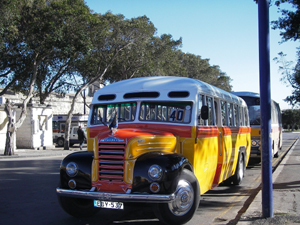 |
|
Geography/Nature |
|
|
The Maltese archipelago consists of three islands: Malta, Comino and Gozo. The area is 320 km2 and in this space there are about 400 000 inhabitans. (Extra statistics: Every family has on average three cars!) There are also three small uninhabited islands: Cominotto, Filfla and St. Paul. Our winterplace has been on Msida Marina, Malta.
|
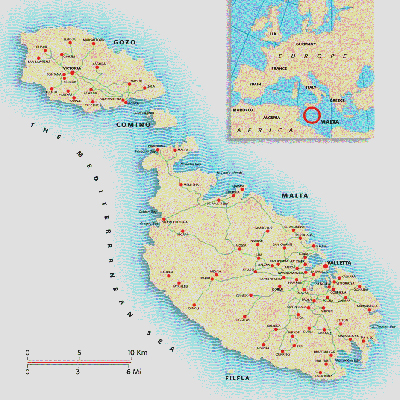 |
|
The greenest of the islands is Gozo which is also more cultivated. Most things are imported here, but enough potatoes are grown for a small export. Malta and Comino are quite barren and what you see is mostly stony ground. The islands consists of lime stone and some clay. Now in the spring, after the wet winter, there are flowers everywhere! Here is a picture of Eivor who carefully smells a "Giant stinkfloka".
|
|
|
Out roaming with a group of sailors. Here is a view of Gnenja Bay.
|
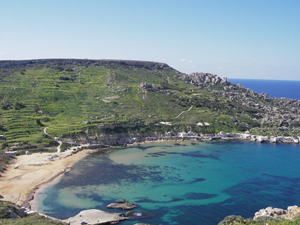 |
|
The cliffs are high on the south coast, but there are more sandy beaches on the northern and western part of the island. In October we went swimming in the Golden Bay.
|
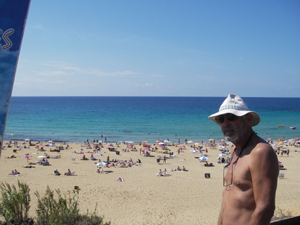 |
|
The last dip of the year took place on the 20th November when we went on a trip to the Blue Lagoon by Comino. The water was crystal clear and very blue!
|
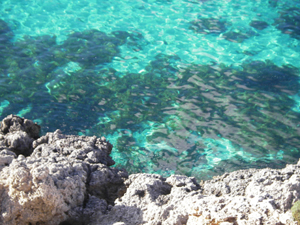 |
|
There are many caves and hollows in the cliffs along the coast.
|
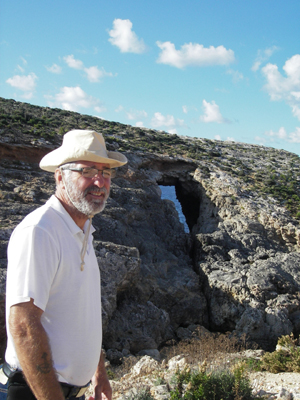 |
|
Here is an Oxalis pes-caprae among the stones. A beautiful flower which was introduced to Europe in the 18th century, which today is considered a weed and forms big fields in the countryside. It has had an opportunity to spread as the countryside has been cropped. We have not seen one single goat, sheep or other agricultural animals here, so it must have happened long before we got here!
|
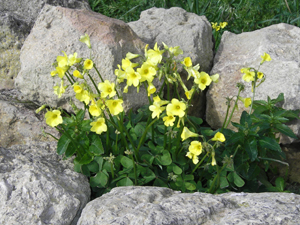 |
|
This maroon flower spreads out as well. I have not found the name for it, but it is thought to be a kind of lupine. There are several different kinds of herbs growing and we have seen people picking wild asparagus.
|
 |
|
There are a lot of cacti and the cactus fruit – “prickly-pears” - are very nice. You have to handle them carefully though. We haven´t got claws like Baloo…
|
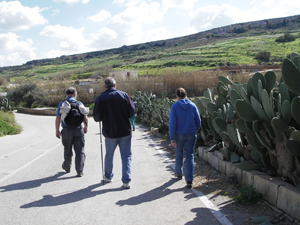 |
|
History mixed with our experiences |
|
|
Malta has a very eventful history. The islands are situated in the middle of the Mediterranean Sea; 90km south of Sicily, 290km north of Africa, 1830km east of Gibraltar and 1500km west of Alexandria. This strategical position has meant that several countries and forces have wanted to rule the islands.
|
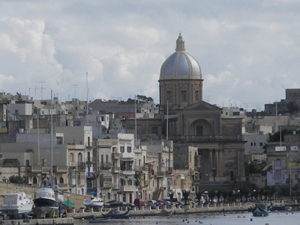 |
|
The first Maltese are said to come from Sicily 4000 BC and were stone age people. They had with them farm animals, pottery, seeds and flint tools. As time passed stone temples were built on the islands. The ruins are today a tourist attraction. Around 1800 BC the temple builders disappeared. The first invasion of the islands is believed to have come from the foot of Italy and was followed by many more. |
|
|
Malta was also desirable because of its´ many nice natural harbours. The Phoenicians took advantage of this around 800 BC. The domestic pottery- and weaving industry received an added boost with a wider export market. The Romas were the next power to rule over Malta. The Maltese were treated more like allies than a defeated people. The Romans build the town Melita (same name as the island) where Mdina/Rabat are situated today.
|
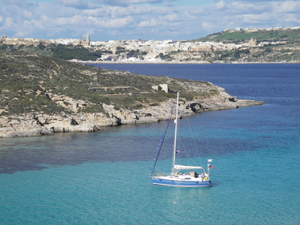 |
|
It is recorded that the apostle St. Paul was shipwrecked outside Malta 60 AD and stayed here for three months. In Melita Paul treated and cured the father of Publius, the Roman official. Publius converted to Christianity as did the majority of the islands inhabitants. Today 95% of the population are Catholics. Publius became the first Bishop in Malta and the church in Melita has been rebuilt several times over the years. Today the Cathedral Church in Mdina occupies this site.
|
 |
|
The 10th Feburary “St. Paul´s Shipwreck day” is celebrated with full Maltese pomp. We went to Valletta to see these festivities, as did many others. It had been rainy and windy for a long time, but this day the sun was shining. The first thing we saw were the beautiful banners and wooden statues – taken out especially for this occasion.
|
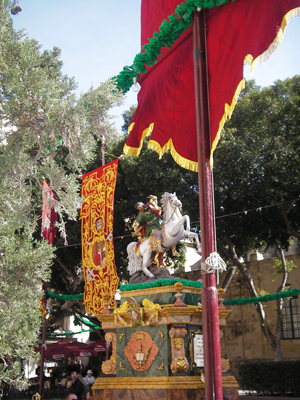 |
|
Soon there were people everywhere and a brass band started its´ march around the streets. It felt strange to see all the people thronging around the band as they made their way through the streets.
|
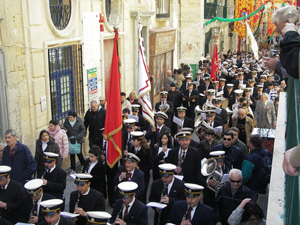 |
|
People were throwing paper, as “ticker-tape”, from the balconies to enhance the festivities.
|
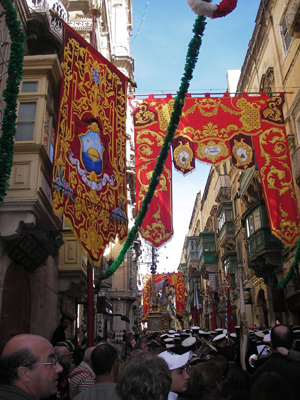 |
|
St. Paul´s Shipwreck Church is an incredibly beautiful church with lots of decorations in gold and silver.
|
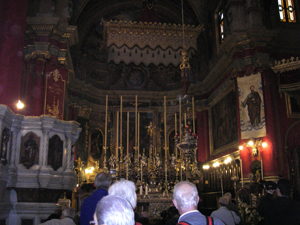 |
|
As darkness fell over Valletta the religious procession started. Eight strong men were carrying the statue of St. Paul.
|
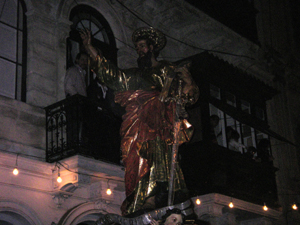 |
|
The dignitaries of the Church led the procession. The evening finished with fabulous fire works – as it often does in Malta.
|
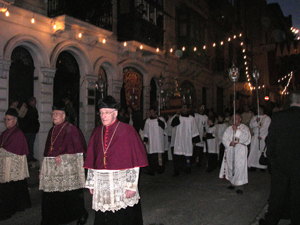 |
|
The Arab attacks on Malta started around the year 836. There were a lot of political intrigue between the countries surrounding Malta, which I will not delve into. What I would like to tell you is that the Arabs introduced the waterwheel, “sienja”, a construction driven by animals to retrieve the water. They also started to grow cotton, which became the basis of the Maltese economy during several decades. |
|
|
From 1090 to 1194 the Normans ruled on Malta. The Germans came in through the “Swabians” 1194, the French 1268 through the “Angevins”, Spain through the “Aragones” 1283 and “Castilians” 1410. During this period the Christian religion was strengthened and was established through the Fransiscans 1370, the Carmelites 1418, the Dominicans 1466, Minor Observants 1492 and the Benedictine Sisters 1418. |
|
|
|
|
|
The Knights of the Order of St. John |
|
|
As a military order, the Knights took part in the Crusades, but were driven away 1291 and ended up on Rhodes, which they occupied for about 200 years. Eventually they were forced away from the island by the Sultan Suleiman. After wandering for about seven years they were offered Malta as a home by the Roman Emperor Charles V. They came to Malta 1530. |
|
|
The order can be described as a multinational force divided into sections linked to their different nationalities. These sections, or Langues, were: Auverge, Provence, France, Aragon, Castile, England, Germany and Italy. The Maltese Cross is also the symbol of The Knights of the Order of St. John. The cross originates from Amalfi and the eight points represents, apart from the languages: truth, faith, repentance, humility, justice, mercy, purity and endurance of persecution. |
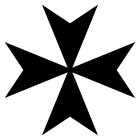 |
|
This period became the first time the conquerors stayed and the island got to keep its´ wealth. But, before then the unforgettable Siege of Malta took place on the 18th May 1565. The Ottoman Turks and their allies attacked the island with 48 000 of their best troops. Against these 540 Knights, 4 000 Maltese and about 3 450 mercenaries from Spain and Italy were fighting. After 31 days of fierce fighting the Fort St. Elmo fell into the hands of the Turks, but they didn´t manage to beat the Christian forces that held off until a small relief force arrived from Sicily. The Maltese people drove the Turks out and stood as victors. |
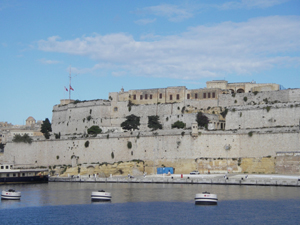 |
|
Valletta |
|
|
The Grand Master La Vallette, who was elected 1557, had great plans of fortifying the sides of Mount Sciberra against hostile attacks. The Siege of 1565 put a stop to this, but as soon it was over, La Vallette put his plans into action. La Vallette died 1568 and is buried in the Church of Our Lady, the first building erected in Valletta. |
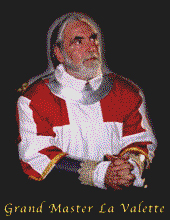 |
|
Here is the court yard of the Grand Master´s Palace. The statue is Neptune.
|
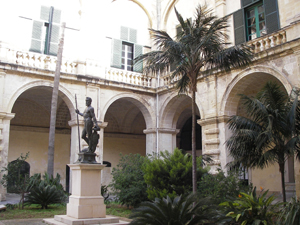 |
|
We took the opportunity of visiting the Knights Hospital in Valletta. All the treatment was free of charge and the patients were well looked after by competent doctors and carers. They were given good food served on silver plates with silver cutlery. It was the easiest metal to keep clean.
|
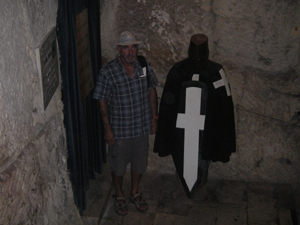 |
|
A high wall surrounds Valletta.
|
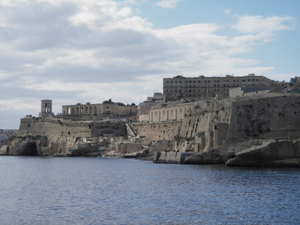 |
|
From the wall there is a nice view of Ta´ Xbiex, Gzira and Sliema. Our marina is at Ta´Xbiex.
|
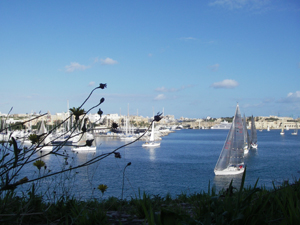 |
|
Along the wall there is a beautiful garden with colourful flowers and fruit trees.
|
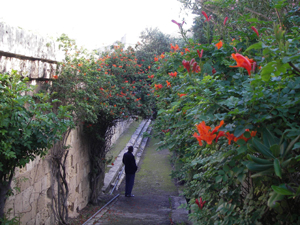 |
|
Just outside Valletta, in Floriana, there is a botanical garden with beautiful plants and a nice view to admire.
|
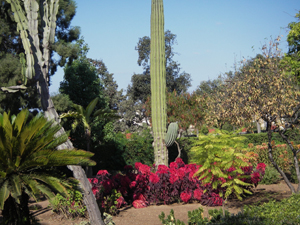 |
|
The fall of the Order |
|
|
Towards the end of the 18th century the unemployment was high and poverty was rife on Malta. The main part of the overseas property belonging to the Order lay in France, where the Republican government took it over. French refugees came to Malta to escape the Revolution and put a greater strain on the economy. As the last Grand Master, Ferdinand von Hompesch, was elected, Napoleon planned to take over Malta. Napoleon invaded Malta 1798 and the island was handed over to him without any resistance. |
|
|
Napoleon plundered the palaces and the larger buildings of all that was valuable. When it came to the Churches he took most of the gold and silver and melted it down to ingots. The Maltese turned to the King of Sicily for help and protection. The Kings representatives were sent to their allies, the British, passing on the Maltese request. The French surrendered year 1800. |
|
|
The British were not interested in possessing Malta as much as keeping the French out. Through the Treaty of Amiens 1802 it was decided that Malta should be returned to a reformed Order of St. John. Valletta became the most important centre of trade in the Mediterranean. Through the Treaty in Paris 1814 Malta became British. |
|
|
|
|
|
Malta has played a strategical part in history and has also been called the “Nurse of the Mediterranean” through taking care of sick and wounded in war time, such as the Crimean War and the First World War. 1921 Malta was granted self government with responsibility for domestic politics. The British controlled the defense, foreign policy and immigration.
|
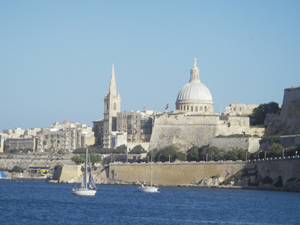 |
|
The political factions could be classified into three groups: the pro-British group who opted for the advancement of the English language and culture as well as the dissemination of the Maltese language, the pro-Italian group who stood for the development of Italian and English and the Italian culture and the newcomer “The Labour Party” who advocated compulsory education, the promotion of the English and Maltese language and the improvement of working and social conditions. In the troubles that followed with a suspended Constitution, after an election where the pro-Italian party won with the blessing of the Church, Malta reverted to colonial rule. |
|
|
So, what language is spoken today? It sounds like a mixture of everything! You can hear the Arabian influence. Sometimes you can hear Italian words and then words that must be Maltese. In all this English is mixed up. All numbers are spoken in English. All traffic signs are in English. We often hear Maltese conversations ending in: “Ciao, ciao, see you tomorrow!” It must be a very difficult language to learn! |
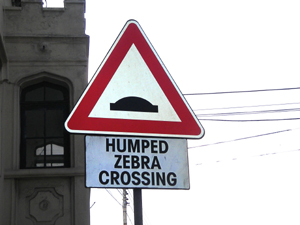 |
|
The second world war broke out and with its´ strategical position Malta was again very attractive for many. I will not comment all that happened during this war, but will mention Hitler´s bombardment of Malta in April 1942. During 12 days 10 hours and 20 minutes 6,727 tons of bombs were dropped by 3, 359 bomber planes. 339 civilians and 208 servicemen were killed. On the 15th April 1942 the people of Malta were awarded “The George Cross” by King George VI for their bravery.
|
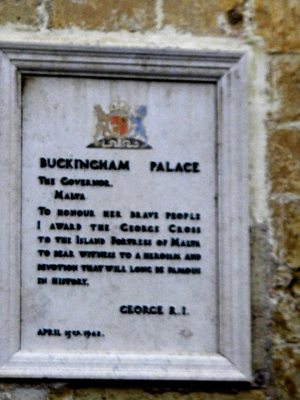 |
|
During one of our excursions, this time to Mgarr on Malta, we visited underground rooms which were used as shelters. You could not mistake the pride in the young guides voice as she told us the story.
|
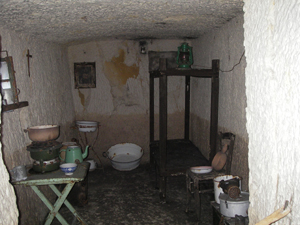 |
|
A whole society worked underground with school, hospital wards, etc.
|
 |
|
After the war discussions carried on about independence and Malta became independent within the Commonwealth the 21st September 1964. Queen Elizabeth became also Queen of Malta. On the 31 March 1979 The Military Base Agreement was terminated and Malta declared itself neutral. Tourism remains one of the main pillars of Maltese earnings although foreign investors play an important role in the countries´ economy. The Maltese people are proud and independent but are also aware that financially Malta cannot stand alone. Since 1st May 2004 Malta is a member of the European Union and since February 2008 also a member of the EMU. (Source: “Malta – Gem of the Mediterranean” and my interpretations. Should there be any mistakes or faults they are entirely of my own making) |
|
|
|
|
|
Buildings, signs, etc. |
|
|
Along the coastline there are a lot of big hotels looking like hotels do. They seem to look the same wherever you go.
|
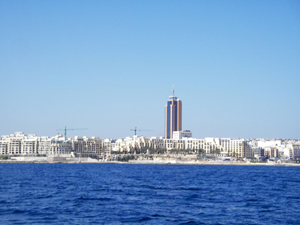 |
|
But if you stroll into the smaller streets you find the typical balconies or bay windows very frequent on the islands.
|
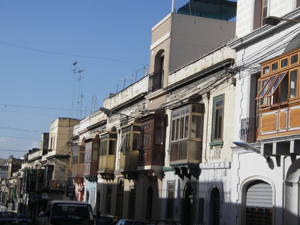 |
|
|
|
|
The building material is the local lime stone and cement. Wood is imported. The yellow lime stone can be seen everywhere and you can also see how after time the stone deteriorates. It is quite soft.
|
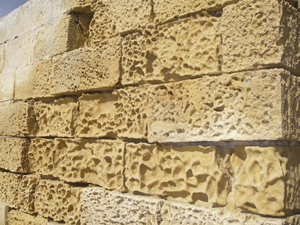 |
|
It is not just people building homes in lime stone…
|
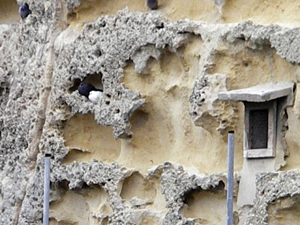 |
|
On many street corners you find statues of Saints who are there to protect you. Here you see a few examples.
|
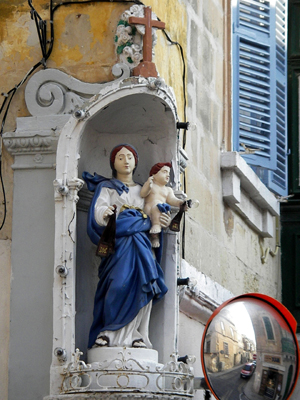 |
|
Here is another one... |
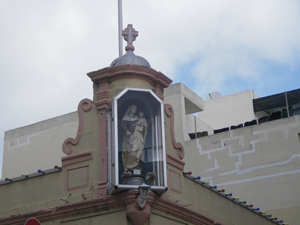 |
|
They are building everywhere on Malta! Suddenly you realize that a building has disappeared and that construction has started on a new one in the gaping hole left. A lot of buildings are also empty waiting for something to be done. It feels as if the whole of Malta is being re-built!
|
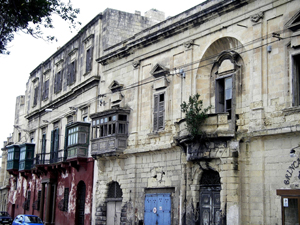 |
|
During our walks we have seen different signs. Like this one for example. A Catcafé.
|
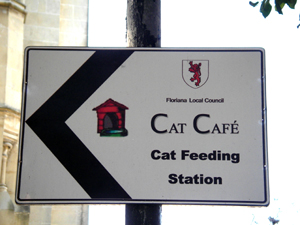 |
|
There are a lot of wild cats here and people enjoy feeding them. Every morning we see people with food for the cats on the breakwater. We were not so happy when the cats came on board and sharpened their claws on the canopy and urinated everywhere. The situation improved when we moved to a pontoon further into the creek where there are no cats.
|
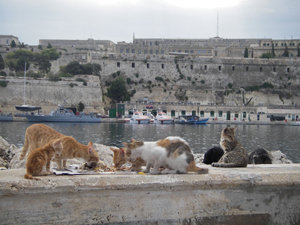 |
|
This sign we have seen in several places and it is definitely needed. When it rains the water is gushing down the streets, hills and down steps in such abundance that it causes problems.
|
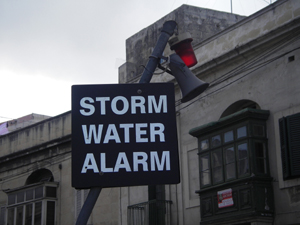 |
|
I tried to catch these floods in a picture, which didn´t succeed. Here a picture of rain. More pictures in the picture gallery.
|
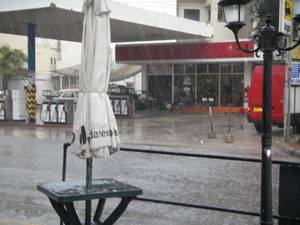 |
|
With murder in mind |
|
|
Yes, we became quite murderous when we realized that we had cockroaches on board!
|
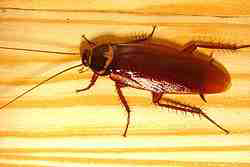 |
|
It took us several months to get rid of them after having tried various methods. The only thing was to acquire information and knowledge about how they work and live and then go to attack. The most effective substance we found in England (e-Bay) where our English friends went for Christmas and bought us a supply. |
|
|
The remedy we found is called Max Force and contains Fipromil. After eating this the cockroach doesn´t die instantly. It has got time to reach his mates where he dies. The mates eat him up and get poisoned that way. Research has shown that one poisoned cockroach kills another 44. The most effective way of getting rid of them. After putting some Max Force down we haven´t seen any more of them. Nice, as they are quite repulsive, don´t you agree!
|
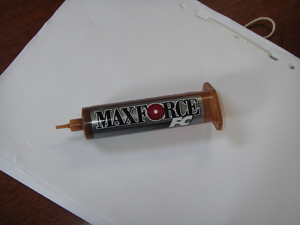 |
|
The Blue Lagoon – Comino |
|
|
Comino is named after a plant that grows on its´ shingly earth: wild fennel or cumin. |
|
|
In November we went out with Rosa di Venti and Dave and Lindsay Kitson to the Blue Lagoon between Comino and Cominotto. They have a Southerly with a keel that can be lifted. It felt strange to anchor with a sailing boat in water just over one meter. In the background you can see Gozo and the town of Mgarr.
|
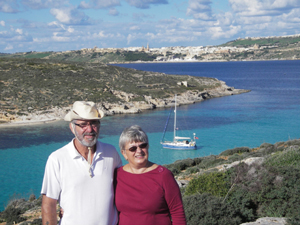 |
|
Dave and Mike took the opportunity to dive under the boat and scrape the propeller. This was the 20th November!
|
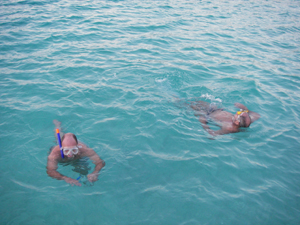 |
|
We took the dinghy “Tinker” to the shore, but first we went through a passage in the cliffs. It was a majestic feeling.
|
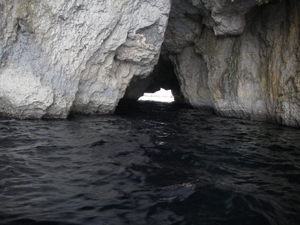 |
|
Safely on land we climbed up to the summit and put several stones on the cairn that had been started. After a couple of lovely days spent here we returned to the Msida Marina.
|
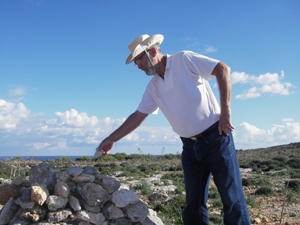 |
|
Maintenance on the boat |
|
|
This winter we have been working on a lot of improvements. |
|
|
The experience of having lived on the boat and also sailed her for over a year has shown us how we really like to have things. We have in other words made life easier for ourselves! |
|
|
The seams on our sprayhood started cracking up so we had them sewn again. We took the opportunity and also had new “windshields” sewn for the sides with WINDY written on them. Mike constructed new Lazy Jacks for the boom, which were also sewn. He also designed a tent for the forward hatch, so that it can stay open when it rains. Steve and Sue, who have started their own business on Malta - InsideOut, did all this work for us. Very nice people.
|
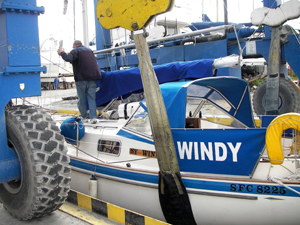 |
|
We have sewn a sun cover ourselves that covers the cockpit and the sprayhood windows (on our machine) and a windscoop (by hand). We have seen windscoops in Italy costing about €50. Now we bought the material for €1,50 and made it ourselves. Own design, of course!
|
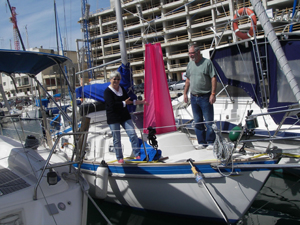 |
|
|
|
|
We chucked the old toilet out! Now we have a new throne to sit on and we have also altered the “pipework” so that we have a swan neck. Earlier the toilet could flood if you happened to forget to turn the tap off. This cannot happen now. Talking of which reminds me of the new bilge pump we bought. We have also replaced the pipe work from the water tank to the sink. Much better.
|
 |
|
New toothbrush holders! Pegs screwed onto a teak list. The toothbrushes can´t fall off and stay fresh. We have also painted the walls in the toilet area!
|
 |
|
Mike has built a new battery box and increased our battery bank as we have found out that we need more power. We have new sockets in various places for shore power which makes life easier. We have bought new 240V lamps that brighten up our lives when we are in port. We have also installed a 12V fan which we are looking forward to using in the summer.
|
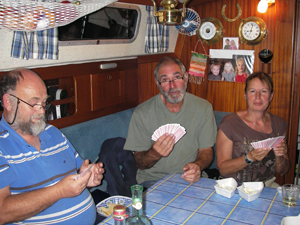 |
|
When we were home at Christmas we took the opportunity of going to Hjertmans (shop in Sweden) and bought a Navtex which is now installed. Navtex = weather reports/navigational warnings, etc. |
|
|
|
|
|
We had some welding work done to a new roll for our CQR-anchor. This will hopefully make it easier to handle the anchor. We have also replaced lines for our sails as the old ones became fluffy or nappy. For the winches we have bought something called “Winchers”. It is a rubber construction which is slipped on the winch. As you pull the line it gets locked onto the winch. Should make life easier when we are sailing.
|
 |
|
The engine has been a chapter on its´ own. As usual. We “conserved” the engine as you do in the autumn and gave it a service in the spring as you should. We noticed that the fuel pump was leaking and after a few trips to the Volvo dealer we bought a new one. A couple of days before Christmas (flights already booked to Sweden) we discovered water in the oil! Nothing else to do but to pump it out, change filters and oil a few times. It was difficult to put the finger on what caused it, but we managed to get the oil pumping around in the engine (without water) before we left for Sweden. When we got back we tested it again and everything seemed normal. Until one day when smoke was belching out of the exhaust and we thought it looked blue. A new round of detective work started! We asked a mechanic to come out and look at it. He looked at the smoke and stated that the engine had to come out for him to be able to investigate properly. He was going to give us a quote for this. We haven´t seen a trace of him since. We got some expert advice on the smoke which, according to him, was not blue but grayish white. We had tanked up with Tunisian diesel, which we had had in plastic containers and wondered whether this might have caused it? It didn´t cause it – but now we had water in the oil again! New oil changes… Then the oil looked as it should again. Now we also discovered that the engine didn´t go up in revs as it should. After having bought a new gear box cable, as the old one looked worn, and installed it the engine is now purring like a cat! We went out for a test run and everything seems to be in order now. Thank Goodness! |
|
|
At the end of March/beginning of April we lifted Windy up on land to paint the hull. It was two years since she was last painted. But before we got to the yard we had to ask a diver to go down and scrape the propeller as we couldn´t get anywhere! It was completely covered in barnacles, but the hull itself wasn´t too bad.
|
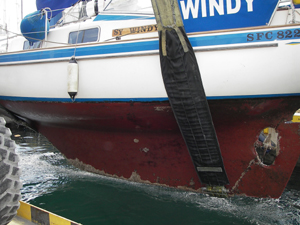 |
|
When the boat was up on land we were visited by geese that were eating tidbits off the hull of the boat. Do you know that they can be really vicious? One day when I was on my way back to the boat (from the showers) one of them started to snap at me. I increased my speed – so did the goose. In the end I was running with a hissing goose behind me! It chased me all the way up the ladder to the boat. I suppose that you shouldn´t start running…
|
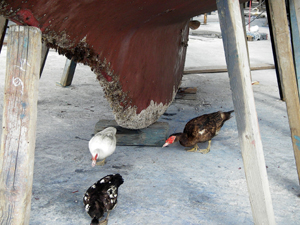 |
|
The stuffing box on the propeller shaft was leaking so we intended to change the packing now that the boat was up on land. We decided to take the whole shaft off to make life easier. So we thought. It was stuck fast and we couldn´t budge it. In the end we asked two mechanics from the boatyard to look at it. In the end they had to drill it out. A little bit of repair- and welding work and we have a different connection, which should be easier to handle. Can you change the packing without taking the shaft out? Of course, but we chose to do it this way. For better or worse.
|
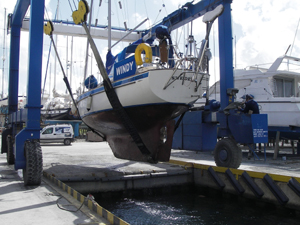 |
|
The next problem to solve was to find a zinc anode that fitted our propeller shaft. We got hold of the agent for Malta. He had 400 different kinds of anodes – but not the one we needed. We had to have one manufactured for €109! Next time we are home in Sweden, we know what to buy…
|
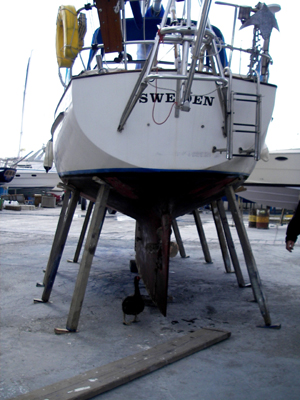 |
|
On the 3rd April we launched her again and now she is ready to sail! |
|
|
Sightseeing |
|
|
Mdina |
|
|
The Roman town of Melita was divided into two parts by the Arabs. The Citadel was called Mdina (The town) and the rest was called Rabat (The suburb). The town has had an eventful history, as you probably have gahered, so here comes just a few pictures of our experiences during our visit.
|
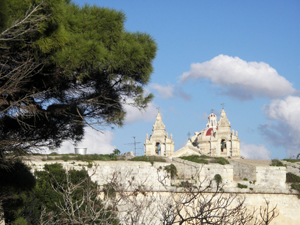 |
|
The town is also called “The Silent City” . Only a few cars are allowed in. When you have crossed the mote you go through a magnificent portal to get to the Citadel.
|
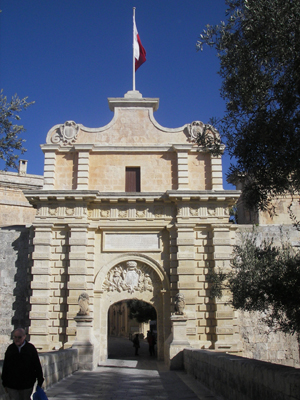 |
|
In the mote there was a grove full of oranges.
|
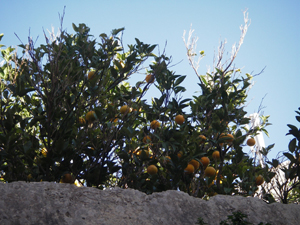 |
|
The streets are narrow and winding. It would be crowded to meet another horse and carriage… The streets were built this way so that arrows shot with a bow could not go around corners.
|
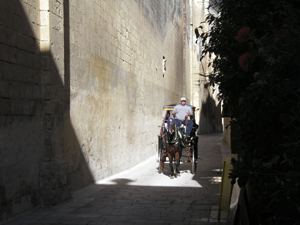 |
|
On our way to St. Pauls´s Cathedral we passed this café in a square.
|
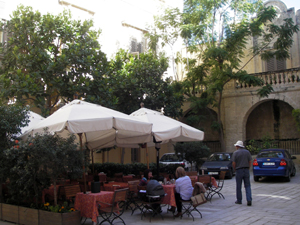 |
|
The bougainvillea was flowering beautifully along the walls…
|
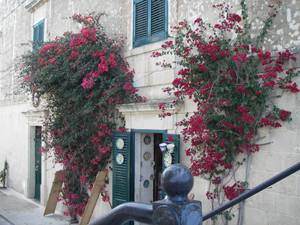 |
|
The Cathedral is fantastic with its paintings and decorations. Here a few pictures…
|
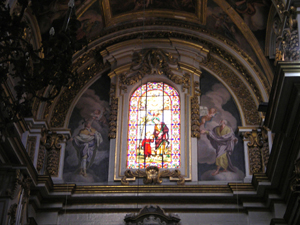 |
|
Here is another one... |
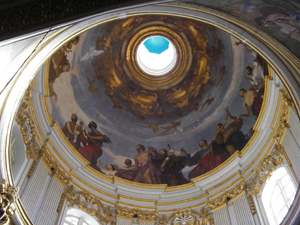 |
|
We walked to the wall to admire the view…
|
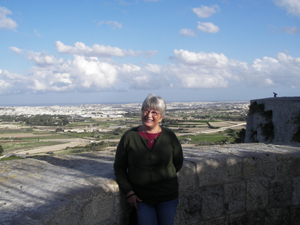 |
|
This place was emanating peace… More pictures in the gallery…
|
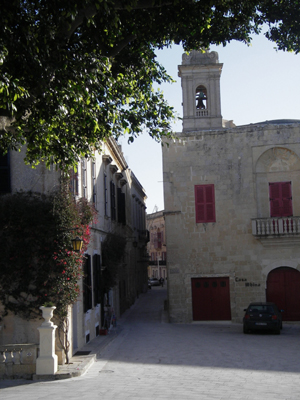 |
|
Mosta |
|
|
Mosta is approximately in the middle of Malta and what is characteristic is St. Mary´s Church, which often is called the Mosta Dome. The Dome is the third largest in Europe after Rome and London. The Church is completely round.
|
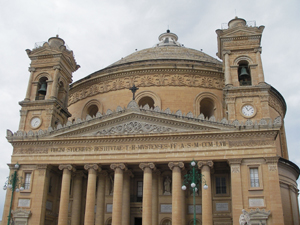 |
|
The building was started 1833 and was finished 1871. You might think that it took a long time to build, but it was entirely built with voluntary labour after people had finished their daily grind.
|
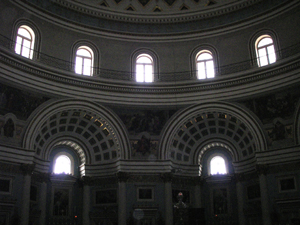 |
|
1942 a 500kg bomb fell through the dome and rolled through the Church – without exploding.
|
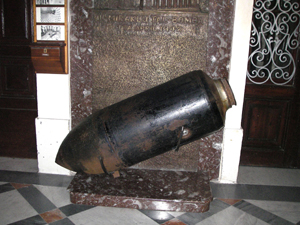 |
|
The ceiling is magnificent…
|
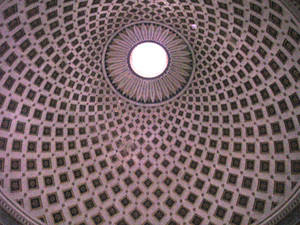 |
|
As most churches in Malta it is built with two clock towers and a dome. On the clock towers there are clocks showing different times. This is to confuse the Devil…
|
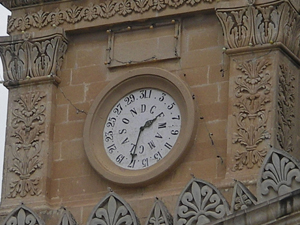 |
|
Food |
|
|
The national dish in Malta is rabbit and on Sundays families often go to a restaurant to eat. We tried this one Sunday as we were on an outing with our fellow sailors. It was very enjoyable and tasted a little bit like chicken.
|
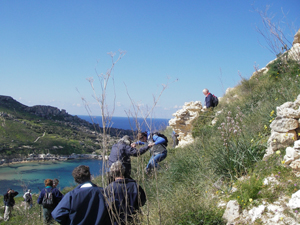 |
|
We have enjoyed the possibility of buying unusual kinds of fish which we can´t get hold of at home. On Mondays Lindsay and I used to stop off at St. Paul and buy fish at Azzopardis fish shop, where there were lots to choose from.
|
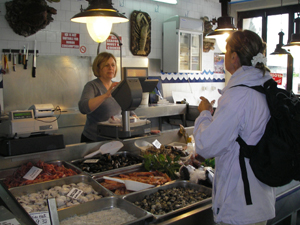 |
|
Here is some fish I already have forgotten the name of! But it tasted good…
|
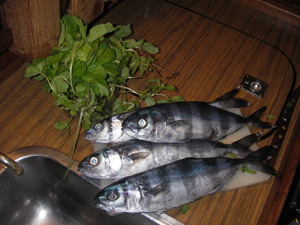 |
|
We also stopped off at Chapelle Café next to the fish shop and had a cup of Cappuchino. Here you can get the best cup of Cappuchino in the whole of Malta!
|
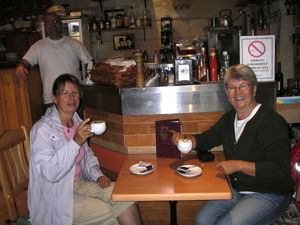 |
|
Here a picture of the very nice proprietors.
|
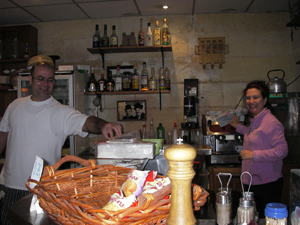 |
|
Mostly we have cooked our meals on the boat and only been to restaurants three times during our visit. |
|
|
Training |
|
|
During the winter Lindsay and I have been going to Curves to train. Here is a picture of Michelle, me and Therese Bartolo, who is the owner/manager. It is strength- and aerobic training solely for women. The results are very good and I can truly recommend this form of training. On Malta you can find them at 28b, St. Helen Street, Mellieha, tel: 21 520783. |
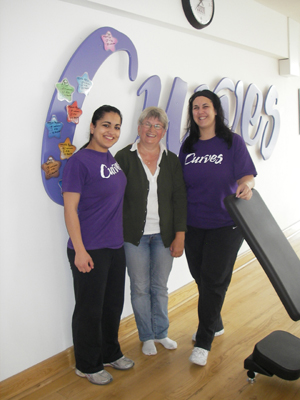 |
|
Live-aboards |
|
|
We have got to know a lot of sailors during our visit who enjoy the same way of life as we do. Weather permitting we have gathered to enjoy a meal/barbeque together. We have grilled our meat and enjoyed our joint salads by the breakwater. Not to mention the exchange of knowledge covering a multitude of subjects.
|
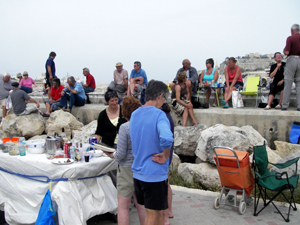 |
|
Here some pictures of people we have had more contact with…
|
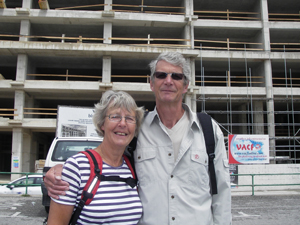 |
| Sören och Eivor Carlsson | |
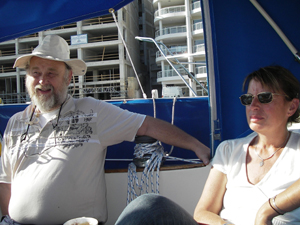 |
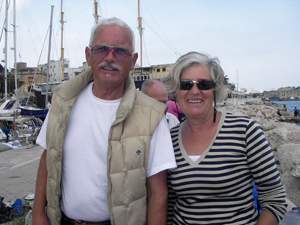 |
| Dave och Lindsay Kitson | Lars och Carin Hedin |
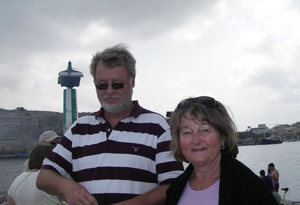 |
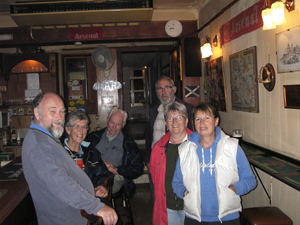 |
| Börje and Ingrid from Märsta | Trish and Ted with us at the Slipway Lounge |
|
Summing up |
|
|
Malta has been a very nice place to winter in. Especially Msida Marina. The Marina is cheap and the price includes electricity and water. The showers and toilets could be better. We don´t know what is going to happen next year as there are talks about it being privatized.
|
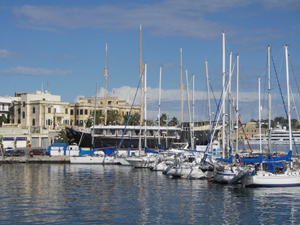 |
|
It has been easy communicating with the Maltese, who have been very nice and accommodating. The buses have been fantastic! They are cheap and you can go anywhere on the islands. As half English it has been a pleasure to go shopping as you can find most things English here as well. It has also been good to find WASA crisp bread!
|
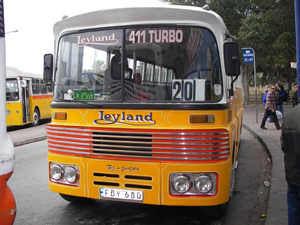 |
|
Now we are looking forward to new adventures in Greek waters and its´ archipelago. We have already booked our next winter place in Finike, Turkey. |
|
|
Last but not least a little reflection: I wonder if there is something magical about the water in Malta? Hair has started to grow on Mike´s bald patch! He is not complaining mind you…
|
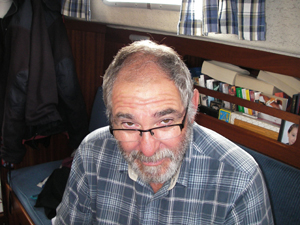 |
|
Have a wonderful summer! |
|
|
p.s. We will be back in due course. |
|
